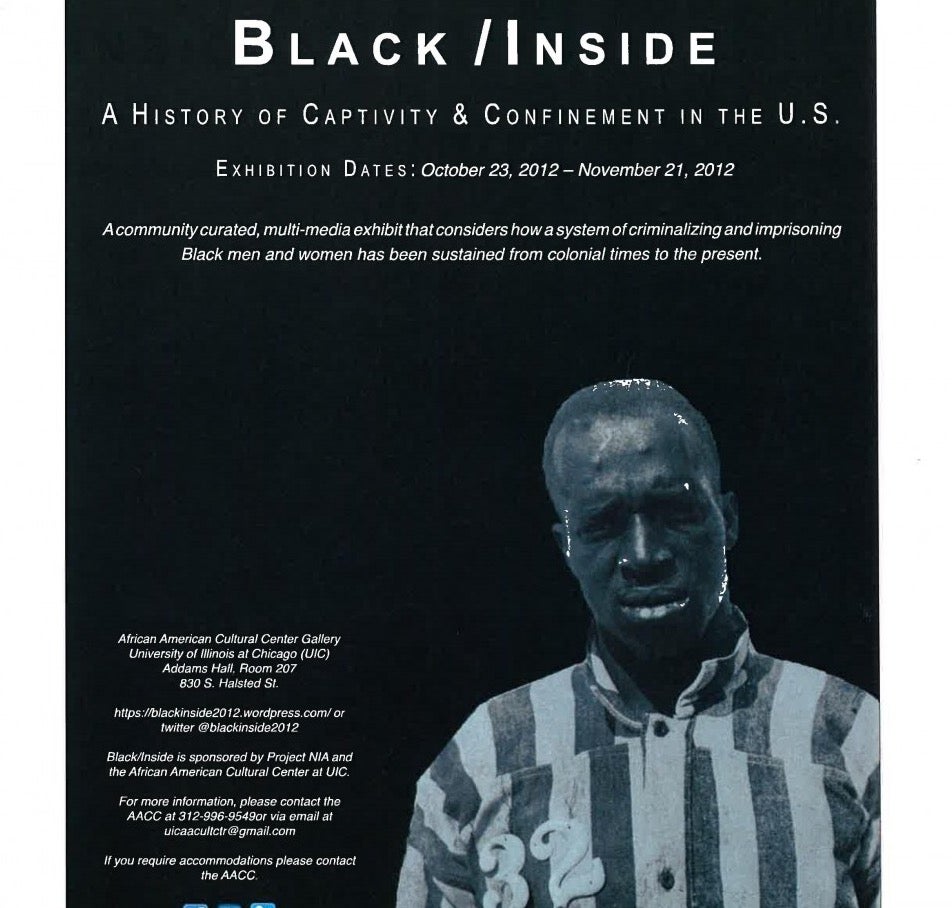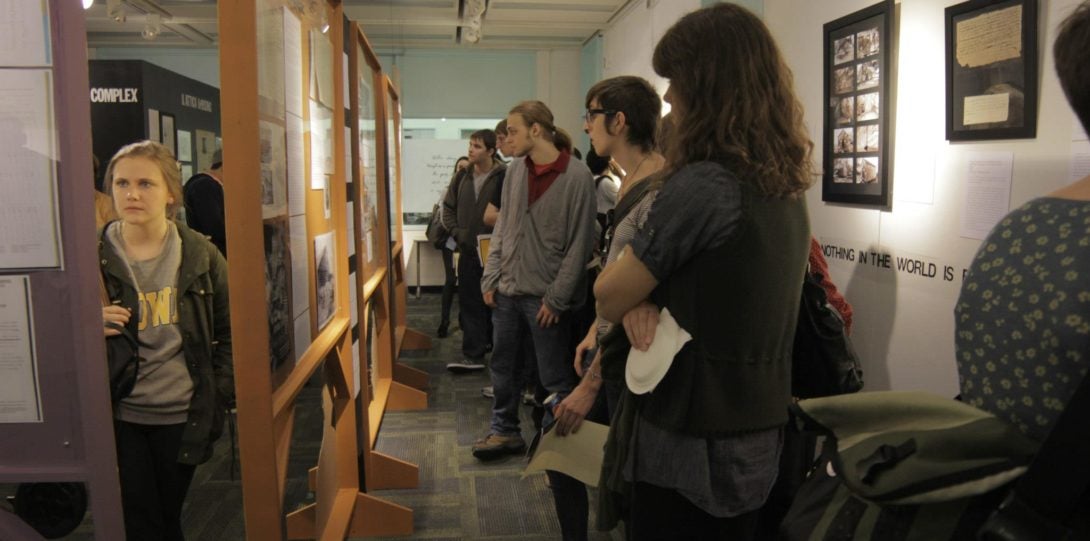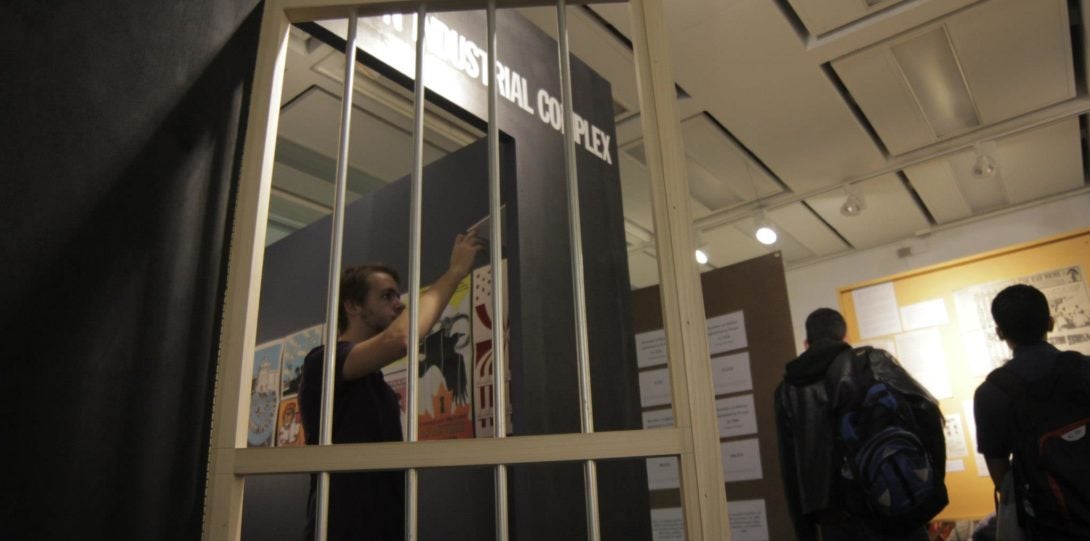Black/Inside
Introduction
October 23 - November 21, 2012 / AACC Gallery
Our flagship fall 2012 exhibition Black/ Inside was curated by: Theresa Silva and Mariame Kaba.
Mounted in conjunction with Project NIA, WHO ARE THEY? Black/Inside events complemented programs sponsored by the Jane Addams Hull House Museum, the UIC Social Justice Initiative, and the Public Square, and served as co-curricular programming for UIC's Department of Sociology (Sociology 105, 220 and 225).
The installation and supporting activities were framed by the following questions, posed by civil rights advocate and legal scholar Michelle Alexander in a recent Rethinking Schools article:
How did we get here? Why is this happening? How are things different in other communities? How is this linked to what has gone on in prior periods of our nation’s history? What, then can we do about it?
Everyone is affected by the prison industrial complex; we wish to dismantle it by asking:
What if prisons redeemed people instead of warehousing them? What if we invested in people and not police and prisons? What if we supported re-entry services for people returning from prison, restoring offenders to useful citizenship? Can we imagine a world without prisons?
Through a collection of never before seen photographs, news articles, prison cards, and letters curated by Theresa Silva (College of Architecture and the Arts at UIC) in conjunction with Miriam Kaba (Project NIA), this exhibit critically explored the history of mass incarceration in this country, specifically through the lens of racism, linking the tragic legacy of slavery with a marked increase in the prison population and system. Moreover, the exhibit endeavored to make incarceration visible to its visitors, reminding viewers that humans locked up exist beyond the walls that bound them, in the lives of their loved ones.
"Necessary...Invaluable...Powerful, Painful, Truthful...Inspiring, Educational, Enlightening...WOW". These were just a few of the words patrons used to describe Black/Inside: A History of Captivity & Confinement in the US. This community-curated, multi-media exhibit considered how a system of criminalizing and imprisoning Black men and women has been sustained from colonial times to the present. The interactive exhibition used multimedia, material objects, a life-sized reconstruction of a jail cell, photographs, daguerreotypes, and other images to historicize "black life" by drawing parallels between the conditions of slavery and incarceration.
Black/Inside
Necessary…Invaluable…Powerful, Painful, Truthful…Inspiring, Educational, Enlightening…WOW
Black/Inside

Black/Inside included a number of interactive public workshops that introduced spectators to the parameters of the prison industrial complex; a virtual exhibition and popular education guide; guided tours for Chicago Public School (CPS) students and community organizations; and a performance by Stillpoint Theatre Collectives Sisters Rising, a theater ensemble comprised entirely of formerly incarcerated women. Black/Inside was prominently featured in traditional media (NPR/WBEZ, WVON, The Chicago Tribune, CAN TV) and social media, covered by the UIC News, and tied to the CPS social science curricula. The project welcomed more than 650 visitors to include: students, social workers, justice system professionals, ex-offenders, public and charter school students, members of faith based organizations, artists and members of the general public.
From comments recorded in our Visitor’s Book, it seems clear that the exhibit and concurrent programming educated, moved, and inspired visitors, many of whom had personal experiences with law enforcement. No one left with the same understanding of the criminal legal system, of the men, women and children who have been incarcerated, or of ordinary people’s ability to mobilize for social change: “Wow, where to begin…They accused blacks of everything…Racism is systemic and institutionalized…I learned so much, particularly about the role everyday people can play in creating change…I will be back”. Such was the support of the project, that when Black/Inside closed at UIC, it moved to an exhibition hall at Trinity United Church of Christ at 400 West 95th, where it was on display for several months.
Black/Inside
Nearly 2.3 million people are locked in America’s prisons and jails today. In the 1960’s Malcolm X suggested that “America means prison.” His statement is even more appropriate today. The United States has five percent of the worlds population and twenty-five percent of its prisoners. To call the United States a prison nation is to be stating the obvious. However, not everyone is equally targeted by the Prison Industrial Complex. African Americans, in particular, are disproportionately impacted by this American epidemic of mass incarceration.They comprise forty-four percent of the prison population even while only making up about twelve percent of the total U.S. population. Over the years, a number of unknown and famous prisoners have written about their experiences of incarceration. The Black/ Inside exhibition considers how a system of imprisoning black men and women in the United States has been sustained from colonial times to the present. One of the goals of the exhibition is to feature the voices of black prisoners addressing their experience of captivity, confinement and freedom. George Jackson, who became known as one of the Soledad Brothers is a terrific example of a prisoner whose writing helped to illuminate the experience of incarceration for a whole generation of people across the world. He wrote that his life as a black man in America prepared him for his prison experience.
Black/Inside
Black men born in the U.S. and fortunate enough to live past the age of eighteen are conditioned to accept the inevitability of prison…Being born a slave in a captive society and never experiencing any objective basis for expectation had the effect of preparing me for the progressively traumatic misfortune that led so many black men to the prison gate. I was prepared for prison. It required only minor psychic adjustment.
| New York, Coward McCann & Bantam, 1970
Black/Inside
Wow, where to begin…They accused blacks of everything…Racism is systemic and institutionalized…I learned so much, particularly about the role everyday people can play in creating change…I will be back

